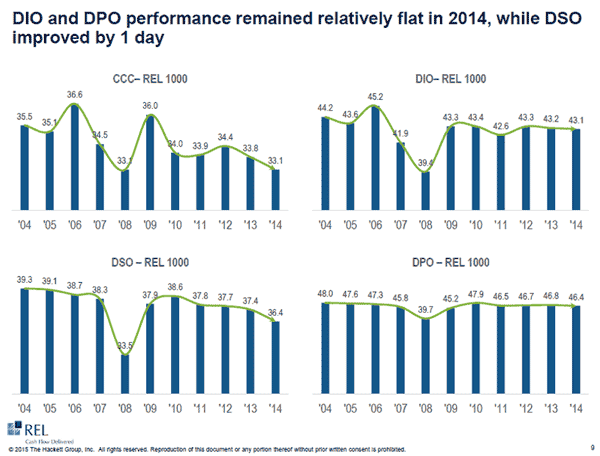Ok, here in the dog and back to school days of August, I decided to milk one more column out of our annual work with the working capital data supplied again to SCDigest from REL, a Hackett Group company.
Last week's columns summarized inventory turns by over 60 industry sectors (created by SCDigest from REL's less granular grouping), as well as which companies had the highest and lowest turns in each of these sectors. (See Inventory Performance 2015 Part 2.)
Gilmore Says: |
 It is fascinating to me to see the competitors with very similar turns - but more often than not there are rather significant differences in those values within each sector. It is fascinating to me to see the competitors with very similar turns - but more often than not there are rather significant differences in those values within each sector.

Click Here to See
Reader Feedback
|
This week, a couple of more things.
First, this interesting chart in REL's own report, summarizing working
capital performance over the past decade overall and in its individual
components, as shown below:

You can see overall cash conversion
cycles are down about 7% from 2004 (an improvement). Inventory
performance as measured by Days Inventory Outstanding (DIO) has improved
about 2.5% over the same period, though is basically flat with 2010.
And despite all the articles about big companies stretching out payments
to suppliers over the past few years, Days Payables Outstanding (DPO)
levels have contracted since 2004 and 2010, meaning payments are
actually being made slightly faster on average.
With
that relatively brief introduction, below you will now find a list of
select grouping of companies in the same sectors and their inventory turn
numbers in 2014. Think you will find it interesting:

It
is fascinating to me to see the competitors with very similar turns -
but more often than not there are rather significant differences in
those values within each sector.
Why,
for example, are turns at Pepsico so much higher the Coca-Cola's? I
don't know for sure, but suspect it is because a significant share of
Pepsico's business is from snack foods, which have to turn fast due to
freshness issues.
But
why does chemical maker HB Fuller have nearly three times the turns of
DuPont? I have no idea, just that there are many variables in inventory
levels, from service policies to supply chain models to
trade-off management and much more, often including skills
and processes.
And as we noted last week, toy maker Hasbro had slightly better turns than rival Mattel (6.0 versus
5.4), but if Mattel had equaled Hasbro's level, it would have generated
an extra $58 milllion in cash flow in 2014.
Ok,
I promise I am done now for 2015. But I'll be back for more next year,
with a few expansions, based on some of the requests I have received in
recent weeks.
Any reaction or other analysis to this inventory data? Let us know your thoughts at the Feedback button or web form below.
|